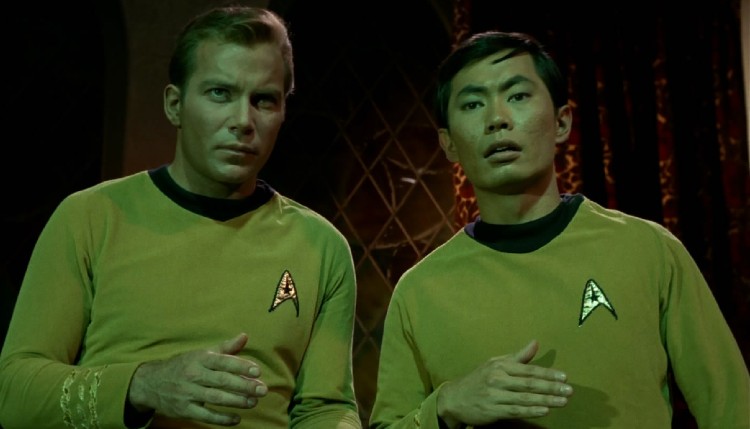“I object to you. I object to intellect without discipline. I object to power without constructive purpose.”
The Enterprise is headed toward colony Beta VI when a planet pops up out of nowhere. Moments later, Sulu and then Kirk vanish from the bridge. After a search of the ship, Scotty and Spock surmise the missing helmsman and captain are down on the planet, even though meteorologist Jaeger tells them the planet is uninhabitable. Spock sends Jaeger, McCoy, and utility player DeSalle down to the surface wearing flimsy oxygen masks. They discover a small section of the planet has been altered to contain a breathable atmosphere.
In the thick of a studio forest, they find a castle and enter where they see a large drawing room and Sulu and Kirk in a display case (and still in their original packaging!). General Trelane (retired) introduces himself and sits down to play at a harpsichord. He revives Sulu and Kirk, who demand that the landing party be permitted to return to the ship, but Trelane isn’t having any of it. He wants the landing party to entertain him for reasons that are not explained until the delightful ending. Spock cuts through the subspace interference and beams up the landing party, but Trelane is one step ahead of them.
There’s a frustrating point of contention among Star Trek fans, new and old. Is Trelane a member of the ‘Q’ Continuum? Roddenberry had stated such several times, perhaps as a way of giving credit to Paul Schneider without paying him the royalties he would be due when “Encounter at Farpoint” rolled around. Roddenberry was a legendary cheapskate and credit-pilferer. Just ask Alexander Courage and D.C. Fontana. This is where the concept of “canon” irritates me.
What fans take as holy gospel amounts to a few pages of characterization or paragraphs in a writer’s guide. There is established continuity and then there is a slavish devotion to canon. Ripping off ideas from writers is nothing new. Consider the similarities between “The Changeling” and the first Star Trek movie. Let’s look at the similarities between Trelane and Q. They’re both extremely powerful, given to fits and tantrums, youthfully rebellious, and they both enjoy tormenting starship captains. The only difference between the two seems to be that Trelane possesses an overactive libido.
After Trelane abducts the entire bridge crew and brings them to his drawing room, he fawns over Uhura and Kirk’s Yeoman Ross (Venita Wolf). He decks out Ross in a stunning gown and locks her in a waltz. Q never showed any attention or interest in women. He does attempt to seduce Janeway but only so that she would bear his child to preserve the Continuum. Trelane is a braggart; immature just as a child would be, but his powers are frightening. Kirk, beginning to sense what Trelane actually is, challenges him to a duel.
Trelane deliberately misfires and Kirk shoots the mirror behind him, suspecting it of hiding an enormous computer, but why would Trelane require such a machine? When the crew escapes for the second time, Trelane chases after them with his planet like a ball on a string. Kirk has an interesting approach to Trelane. He has no specific set of behaviors when dealing with god-like creatures. He humors him for a time, then toys with him, and finally, he loses his patience, yet Trelane enjoys pulling his strings until Kirk refuses to play. This is an episode I can watch over and over. William Campbell is a joy to watch as he chews the scenery with Shatner.
Star Trek Rewind explores the Star Trek universe. From Archer to Janeway, Kirk to Picard, and Georgiou to Sisko — boldly read what no one has read before!







